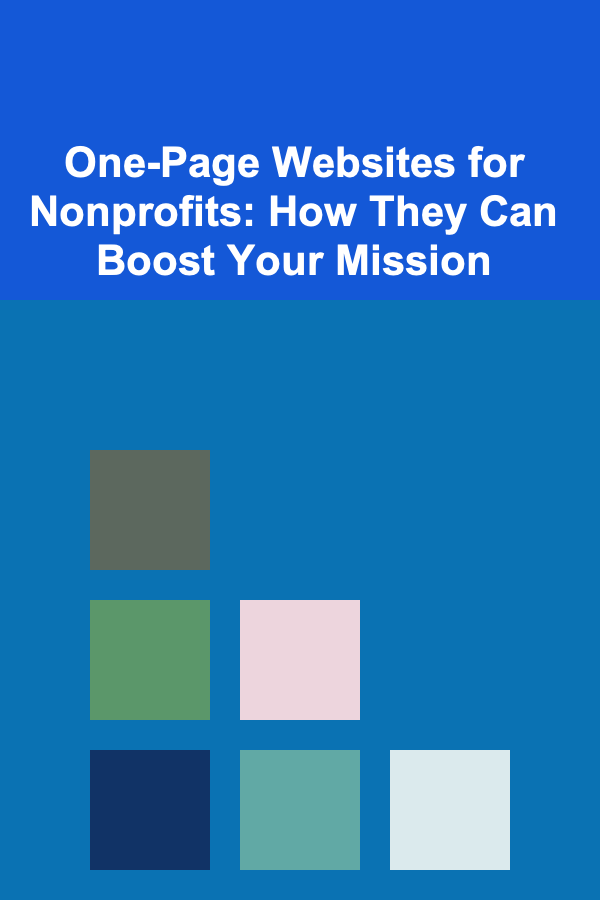
One-Page Websites for Nonprofits: How They Can Boost Your Mission
ebook include PDF & Audio bundle (Micro Guide)
$12.99$10.99
Limited Time Offer! Order within the next:

In today's digital age, having a strong online presence is crucial for all types of organizations, including nonprofits. Nonprofits often face unique challenges, such as limited budgets and a constant need to engage with supporters and donors. One-page websites have become an increasingly popular solution for nonprofits, offering an affordable and efficient way to create a compelling online presence.
A one-page website consolidates all necessary information into a single, easily navigable page, allowing visitors to quickly find what they need without the distraction of multiple pages and complex navigation. For nonprofits, this approach can streamline communication, increase engagement, and even boost donations. In this article, we will explore how one-page websites can support nonprofit missions, highlight the benefits of such websites, and offer best practices for creating an effective one-page site.
Why One-Page Websites for Nonprofits?
1. Simplified User Experience
One of the biggest advantages of a one-page website is its simplicity. Nonprofit websites, especially those with limited resources, often need to communicate their mission, values, and goals in the most concise manner possible. One-page websites eliminate unnecessary distractions and streamline the message, allowing visitors to focus solely on the nonprofit's cause.
By focusing on a single page, nonprofits can guide visitors through their story more effectively, ensuring that each element on the page serves a purpose. A one-page site is often easier for users to navigate, which can lead to a better experience and higher engagement.
2. Cost-Effective and Quick to Launch
Building and maintaining a multi-page website can be expensive and time-consuming, especially for smaller nonprofits with limited budgets. One-page websites, in contrast, are much more affordable and quicker to build. The limited scope of content reduces the need for complex features, making it easier for nonprofits to design, develop, and launch a professional website with minimal investment.
Additionally, nonprofit teams are often smaller, meaning that time and resources are stretched thin. A one-page website reduces the complexity of maintaining content, keeping the site updated, and monitoring performance. This makes one-page websites an ideal solution for nonprofit organizations that need to focus on their mission, rather than on the technical aspects of managing a website.
3. Enhanced Storytelling and Messaging
One-page websites provide an ideal format for telling a nonprofit's story in a compelling and coherent way. The single-page format forces nonprofits to distill their mission, impact, and goals into digestible chunks that are easy to follow. This tight focus on key messaging ensures that visitors are immediately presented with the nonprofit's core message, without getting lost in excess information or navigating through multiple pages.
By organizing the content in a logical sequence---from introducing the organization's mission to showcasing the results of their work---nonprofits can engage visitors in a way that encourages further interaction, whether that means making a donation, signing up for a newsletter, or volunteering.
4. Mobile Optimization
As mobile browsing continues to dominate, having a responsive website is essential. One-page websites naturally lend themselves well to mobile optimization. Since all of the content is located on a single page, mobile users can easily scroll through the information without needing to click through multiple pages.
A streamlined layout, coupled with large images, clear text, and intuitive navigation, makes the user experience even more accessible on mobile devices. For nonprofits, this means ensuring that potential donors and supporters can access important information, donate, and sign up for causes, all from their smartphones or tablets.
5. Boosting Conversion Rates
The simple layout and focused messaging of a one-page website make it easier to create strong calls to action (CTAs) that encourage conversions. Nonprofits can use their one-page website to encourage a specific action, whether that's donating, volunteering, or signing a petition.
One-page websites typically have fewer distractions, which allows nonprofits to create a more targeted and streamlined conversion funnel. With clear CTAs placed strategically throughout the page, nonprofits can guide visitors toward the next step, ensuring that the website's goal is achieved with minimal friction.
Key Benefits of One-Page Websites for Nonprofits
1. Improved Engagement and Retention
One of the key challenges for nonprofits is capturing the attention of visitors and encouraging them to engage with the content. With a one-page website, the nonprofit can keep the focus on its mission and vision, leading to a more engaging experience. Visitors don't have to click through multiple pages to get to the information that interests them; it's all available on one page.
Moreover, a one-page website's structure encourages people to scroll, which often results in a more involved experience. A well-designed site can keep people engaged for longer periods, and as they scroll through the content, they are exposed to the full narrative of the nonprofit's work, the impact it has, and how they can get involved.
2. Faster Load Times
One of the often-overlooked advantages of a one-page website is the speed with which it loads. Since there is only one page to load, these websites can load significantly faster than multi-page websites, which require multiple requests to fetch different content. Faster load times are especially important for mobile users, as slow-loading websites can lead to higher bounce rates.
The faster your website loads, the more likely users are to stay on the site, interact with the content, and take the desired action. This could mean increased donations, more volunteers, or simply greater awareness about your cause.
3. Increased Brand Consistency
A one-page website naturally facilitates consistent branding. Nonprofits often rely on visual elements---such as logos, colors, and typography---to reinforce their brand identity. With a one-page site, it's easier to maintain consistency in the design, ensuring that the organization's brand is reflected clearly in all aspects of the page.
By using a limited number of design elements and focusing on a cohesive visual theme, nonprofits can strengthen their branding. The simplicity of the one-page format also allows the organization's core message to shine, without being overshadowed by complex design elements or cluttered content.
4. Greater Focus on the Donation Process
For many nonprofits, fundraising is a key priority. One-page websites can focus directly on encouraging donations by making the process simple and straightforward. With fewer distractions and a clear call to action, donors are more likely to contribute, knowing exactly how their donation will make an impact.
Nonprofits can also integrate donation forms directly into the one-page website, allowing donors to give immediately after reading about the cause. Whether it's a one-time donation or a recurring contribution, the donation process should be as easy as possible, and a one-page website can make that happen.
5. Easier Analytics and Optimization
Tracking user behavior on a one-page website is much simpler than on a multi-page site. Since all the data is focused on a single page, nonprofits can easily track how users interact with the site, how long they stay, and what actions they take. This data can help organizations understand what content resonates most with their audience, allowing them to optimize their messaging and calls to action.
Additionally, one-page websites make it easier to test different versions of the page and tweak elements to improve performance. A/B testing on a one-page site is more streamlined because the entire user experience is confined to a single page, making it easier to measure the success of design changes and new strategies.
Best Practices for Building a Nonprofit One-Page Website
1. Clear and Compelling Messaging
A one-page website must communicate the nonprofit's mission clearly and compellingly. Avoid jargon or complicated language. Instead, use simple, direct messaging that tells visitors who you are, what you do, and why it matters.
Your website should immediately capture visitors' attention with an impactful headline, followed by a brief introduction to your cause. Make sure the visitor understands exactly what problem your organization is trying to solve and how they can help.
2. Strong Calls to Action
Your one-page website should be designed with a clear goal in mind. Whether it's to increase donations, get more volunteers, or raise awareness, every section of the website should encourage action. This could include signing up for a newsletter, volunteering, or making a donation.
Call to action buttons should be visible and strategically placed throughout the page. Ensure that they stand out, use action-oriented language, and are easy to click on mobile devices.
3. Visual Storytelling
Use visuals to tell your story. A picture is worth a thousand words, and for nonprofits, powerful images can be particularly effective in conveying the impact of their work. High-quality images, videos, and infographics can help bring your cause to life and make an emotional connection with visitors.
Consider using a hero image or video at the top of the page that showcases the work you're doing. Follow this with sections that demonstrate your impact, such as testimonials, success stories, or statistics that show the results of your work.
4. User-Centered Design
Remember to keep the user in mind when designing your one-page website. Ensure that it is easy to navigate, even for those with limited technical knowledge. Organize your content in a logical flow, and avoid overwhelming visitors with too much text or too many design elements. Clear headings, concise language, and strategically placed CTAs will ensure that users can find what they need quickly.
5. Responsive Design
Ensure that your one-page website is mobile-friendly. A significant portion of web traffic now comes from mobile devices, and your website must be designed to provide a seamless experience across all screen sizes.
Make sure images are optimized for different devices, text is legible on smaller screens, and buttons are easy to click. Test your website on various devices before launching it to ensure that it works flawlessly for all visitors.
6. Tracking and Optimization
Once your one-page website is live, continuously monitor its performance. Use web analytics tools, such as Google Analytics, to track user behavior, conversion rates, and other key metrics. This data will help you identify areas for improvement and optimize the website for better results.
Conclusion
A one-page website is a powerful tool for nonprofits looking to boost their mission, engage with supporters, and raise awareness. By simplifying the user experience, focusing on clear messaging, and making it easy to take action, nonprofits can create an effective digital presence that drives impact.
Whether you're a small organization with limited resources or a larger nonprofit looking to streamline your website, a one-page site offers an affordable, efficient solution. By following the best practices outlined in this article, you can create a website that resonates with visitors, strengthens your brand, and helps you achieve your nonprofit's goals.

How to Create a Checklist for Local Event Promotion
Read More
How to Create a Tool Maintenance Schedule
Read More
How to Create a Vision Board for Your Time Management Goals
Read More
How to Create the Ultimate Playlist for Your Home Party
Read More
How to Cut Costs on Home Appliances and Make Them Last Longer
Read More
How to Understand Bonds and Their Role in Your Portfolio
Read MoreOther Products

How to Create a Checklist for Local Event Promotion
Read More
How to Create a Tool Maintenance Schedule
Read More
How to Create a Vision Board for Your Time Management Goals
Read More
How to Create the Ultimate Playlist for Your Home Party
Read More
How to Cut Costs on Home Appliances and Make Them Last Longer
Read More